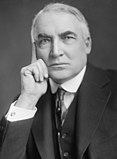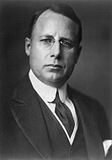| |||||||||||||||||||||||||||||||||
| |||||||||||||||||||||||||||||||||
 County Results
Harding 40-50% 50-60% 60-70%
| |||||||||||||||||||||||||||||||||
| |||||||||||||||||||||||||||||||||
| Elections in Washington |
|---|
 |
The 1920 United States presidential election in Washington took place on November 2, 1920, as part of the 1920 United States presidential election in which all 48 states participated. State voters chose seven electors to represent them in the Electoral College via a popular vote pitting Democratic nominee James M. Cox and his running mate, Assistant Secretary of the Navy Franklin Roosevelt, against Republican challenger U.S. Senator Warren G. Harding and his running mate, Governor Calvin Coolidge.
By the beginning of 1920 skyrocketing inflation and President Woodrow Wilson's focus upon his proposed League of Nations at the expense of domestic policy had helped make the incumbent president very unpopular[1] – besides which Wilson also had major health problems that had left First Lady Edith effectively running the nation.
Political unrest observed in the Palmer Raids and the "Red Scare" further added to the unpopularity of the Democratic Party, since this global political turmoil produced considerable fear of alien revolutionaries invading the country.[2] Demand in the West for exclusion of Asian immigrants became even stronger than it had been before.[3] Another issue was the anti-Cox position taken by the Ku Klux Klan because Cox was viewed by the Klan as too lenient towards Catholicism,[4] and Cox's inconsistent stance on newly passed Prohibition – he had been a "wet" but announced he would support Prohibition enforcement in August[4]
The West had been the chief presidential battleground ever since the "System of 1896" emerged following that election.[5] For this reason, Cox chose to tour the entire nation[6] and after touring the Pacific Northwest Cox went to California to defend his proposed League of Nations and to convince the region that large sums of money were being spent by Harding simply to put Republicans in the White House.[7] Cox argued that the League could have stopped the Asian conflicts – like the Japanese seizure of Shandong – but his apparent defence of Chinese immigrants in the Bay Area was very unpopular and large numbers of hecklers attacked the Democrat.[8] Moreover, the only attention Cox received in the Western press was severe criticism,[8] and he completely ignored charges against misadministration by the Wilson Administration, and in liberal, heavily unionized Washington State where strikes had been particularly extreme since the war ended, Cox's failure to address labour issues proved also very costly.[7]
- ^ Goldberg, David Joseph; Discontented America: The United States in the 1920s, p. 44 ISBN 0801860059
- ^ Leuchtenburg, William E.; The Perils of Prosperity, 1914–1932, p. 75 ISBN 0226473724
- ^ Vought, Hans P. ; The Bully Pulpit and the Melting Pot: American Presidents And The Immigrant, 1897–1933, p. 167 ISBN 0865548870
- ^ a b Brake, Robert J.; 'The porch and the stump: Campaign strategies in the 1920 presidential election'; Quarterly Journal of Speech, 55(3), pp. 256-267
- ^ Faykosh, Joseph D., Bowling Green State University; The Front Porch of the American People: James Cox and the Presidential Election of 1920 (thesis), p. 68
- ^ Faykosh, The Front Porch of the American People (thesis), p. 69
- ^ a b 'The Passing of Woodrow Wilson', The Round Table, 11:41 (November 1920), pp. 14-31
- ^ a b Faykosh, The Front Porch of the American People (thesis), p. 74



